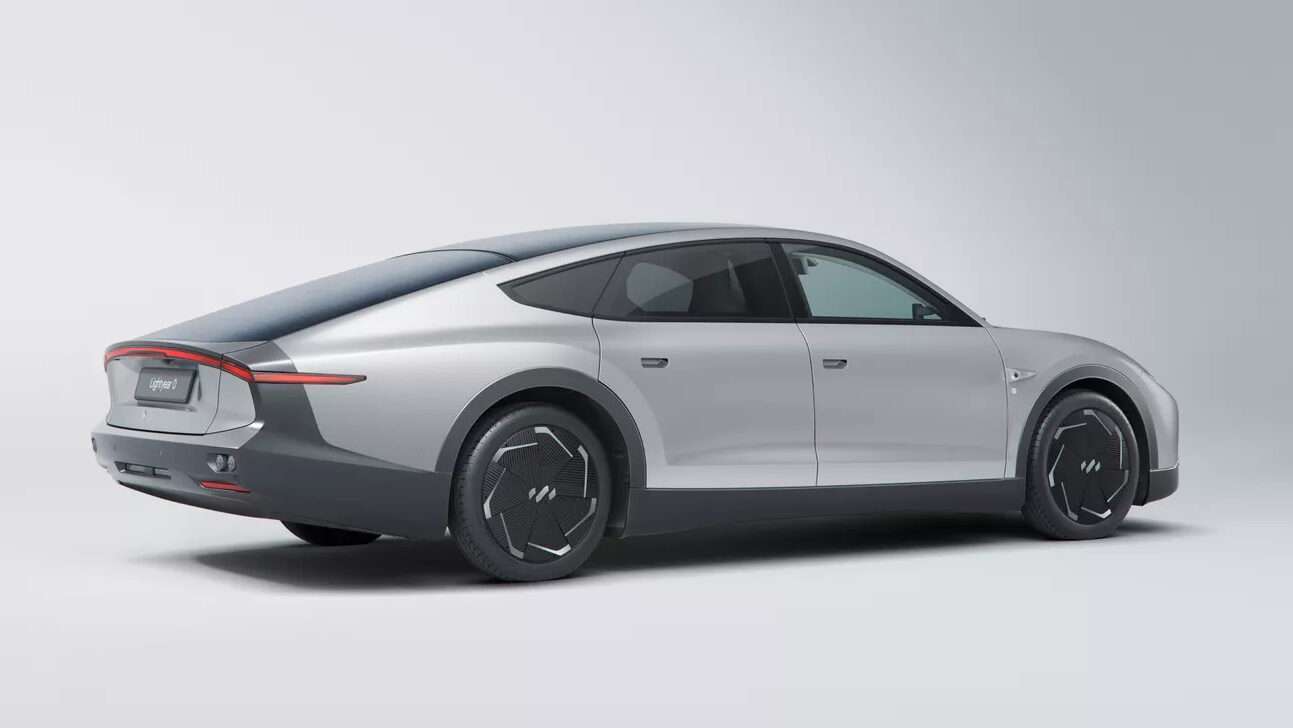Have you ever thought about an electric car that can run up to 7 months without charging? Meet the lightyear 0 the world’s first solar-powered electric car that can run up to 7 months without charging. This car is capable to charge itself with the help of solar panels installed on the roof and on the hood of the car. A lot of people will think that it’s only a concept car but no it’s a production-ready car. Yes you read that right it is a production-ready car and you can even order it from their official website lightyear.one.

On June 9-2022, The CEO & Co-founder of the Lightyear team Mr.Lex Hoefsloot recently Globally premiered their first production-ready solar-powered electric car. You can also watch that Global premiere here.
In the premiere, he talked about the process and the struggle for making this dream possible. He also said that “we all know that conversion cars are part of the problem and electric cars are a step in the right direction. But electric cars add a lot of complexity to their daily lives, but also to the infrastructure. And only half a percent of all the cars worldwide today are electric. So we have to accelerate, we have to be quicker, we have to make a lot of large jumps.”
The yearly global CO2 production has actually gone up 20% and global temperatures have risen. The north and the South Pole both saw rapid temperatures this year. The clock is ticking and yes there is a simpler way to accelerate because we all need to drive sustainable cars by 2040 and 100% sustainable.
So what is the main problem that electric car manufacturers are facing?
Charging points
Charging points need to be installed about four times quicker than it’s currently decaying and that’s in Europe only. Installing charging infrastructure is quite hard cause it requires collaboration between governments, users, institutions, and grid operators.
electric cars
The electric cars that people can buy nowadays are compared to the combustion cars they buy for the same price and are quite complex to use. They have a small range if they try so often, they require planning and quite a lot of planning.
So basically, we’re asking people to drive a car that is less convenient than the combustion car they’re using today. So looking at climate change and the way we live our lives, the question becomes, how do we preserve what we have and still live the life we love.
Luckily, every once in a while, the technology gets to a tipping point that enables a whole different way of thinking. And we should embrace that different way of thinking. Although a lot of people believe it was impossible to make a production-ready solar car.

CEO Mr.Lex Hoefsloot also mentioned their racing experience in a competition held in Australia. Top 45 universities around the world took part in that competition. He also said that “during this competition, the support cars actually have to stop and refuel and the solar cars can keep going. It’s quite the opposite of what people nowadays think about electric cars. So solar cars are not just about sustainability, they’re actually about convenience, it’s about more range, it’s about less charging. And we’d expect the industry to see the brilliance of this and to start building solar cars as well. But up until this day, they find it hard to really embrace the concept. And that’s why, for us, it’s not like an obligation. We’ll have to do this and we’ll have to get to those millions of solar cars and make our lives work.”
Lightyear was founded in 2016 and it took about three years to get to the first prototype. Mr.Lex Hoefsloot also said that “we had realized that we had pushed the boundaries of existing technology. And then we had to develop our own because to get to the targets we have set for ourselves to build a proper solar car, not just a car with solar panels on the roof, we had to develop our own technology. And on top of the technology, we had to get to production, and building cars in production is a lot more complex than building just a prototype.”
In the last three years, the company grow from about 100 people to 500 people and onboarded more than 100 suppliers. They wrote 57 patents and redesigned more than thousands of components to actually be safe, comfortable, and reliable. So to get to production is thinking beyond the car, is thinking about the team and the company. They have driven their prototype 710km and that’s about 440 miles on a single 60-kilowatt hour battery charge. That’s longer than any electric car ever driven on 60-kilowatt hours.
So why do we believe solar cars are a smarter solution?
Every electric car is dependent on the Chargers and the Chargers in turn are dependent on the grid. And the grid then is dependent on still mostly fossil-fueled energy because there are not enough renewables today. Ideally, you don’t want to be dependent on anything, because dependencies in the end slow things down.
So adding a new source, The Sun
The sun adds certainty that you always have that charge and you’ll have to charge a lot less often and therefore make things simpler. And then on the other side, electric cars are still using that fossil fuel energy, and it means we need more clean energy generation in the grid itself. The great thing about adding that solar panel directly to the car is that you don’t have to add that generation anymore to the grid itself. And it’s a shortcut that we as humans can use to speed up the adoption of emission-free mobility and who doesn’t like to use a shortcut for the better?
What is phase zero?
So let’s start with the base and that’s phase zero. Phase Zero is all about paving the way. It’s the preparation phase. It’s showing that the car and the technology can really drive everywhere. Phase Zero is not just about getting the concept and the technology ready. It’s also about getting the first cars to customers. It’s about building those processes and the team, and that’s a very important foundation for the phase.
But it’s not just about getting the company ready. The concept itself is capable because you would be able to drive a proper solo car in 2022. And the moment that a new product comes to market in the automotive industry especially, is very rare, and this one has the potential to change the whole way we look at scaling electric cars, and that’s what Phase Zero is about.
The next phase is phase One. And phase one is all about getting to large-scale production. And it’s about building cars that are more affordable but have the same advantages as its low-volume predecessor that is getting into the market this year.
The Lightyear 1 prototype is going to be produced as Lightyear 0. And in the next couple of weeks, this actual car is going to be seen on the roads in the Netherlands. Because this is the first car that has been approved by authorities and is road legal.
All about the lightyear 0

Lightyear 0 is the record holder in many categories. It is not only the most energy-efficient electric vehicle on the market, but it also has 5 square meters of highly efficient solar cells integrated into the roof and in the hood. What that means is that you can drive further on the same amount of energy. In fact, the solar cells can add up to 70km of driving range per day directly from the sun.
So most people could drive for four months during the summer between charges. In the Netherlands, you could drive for up to two months without charging. And in Portugal, you could drive up to seven months before you have to charge from your plug again. That is based on an average daily commute of 35km. So in the Netherlands, you have a driving range of over 2100km. And in Portugal, it’s three times that 7400km.
The car has motors in each of the four wheels, giving us the lowest energy losses of any electric car powertrain ever built. The company stated that they achieved 560 km at a highway speed of 110 km/h without the sun. It is also the most aerodynamic family car today, with a record-breaking drag coefficient of less than 0.19.
Heating and cooling also play a key role in energy use. Lightyear 0 has an optimized thermal system that intelligently matches energy use with environmental conditions. The mass of the car impacts its energy efficiency. Lightyear 0 is an electric vehicle over 5 meters long, but it only has a weight of 1575 kg. The full body is made out of reclaimed recycled carbon fiber, so it’s lightweight and it has a low carbon footprint.

The interior is made out of vegan materials with plant-based leather for the steering wheel and fabrics made out of recycled plastics. With all the focus on what’s on top of the car, it was still most important to create an interior that is bright, comfortable, and effortless to use.
Specifications
Practical range
1,000+ km driving range between two charging moments
Battery range
625 km (WLTP)
Highway range (at 110 km/h)
560 km
Additional daily solar range
Up to 70 km
Annual solar yield
Up to 11,000 km
Battery pack
60 kWh
Acceleration
0 – 100 km/h in 10 seconds
Top speed
160 km/h
Charging speeds
Amount of range in 1-hour charging
Home charging (regular household plug)
32 km/h
Public charging
200 km/h
Fast charging
520 km/h
Dimensions (L x W x H)
5083 x 1972 x 1445 m
Weight
1,575 kg
Ground Clearance
183 mm
Solar array
5 m² double-curved
Body panels
Reclaimed carbon fiber
Luggage space
Boot 640 L (seats up), Center console 12 L
Seating
5 adults
Sustainability
Vegan interior with naturally sourced materials
Infotainment
10.1’’ display with touchscreen, Android Automotive OS
Side and rear view
Camera system

Hi, I’m Nathan Cross, a writer and avid reader who loves crafting articles for newspapers and online platforms. Words are my passion, whether I’m telling stories, sharing insights, or sparking conversations. When I’m not writing, you’ll find me lost in a book or out on the baseball field, enjoying the game that keeps me grounded. Writing, reading, and baseball—these are the things that define me.





Very well explained